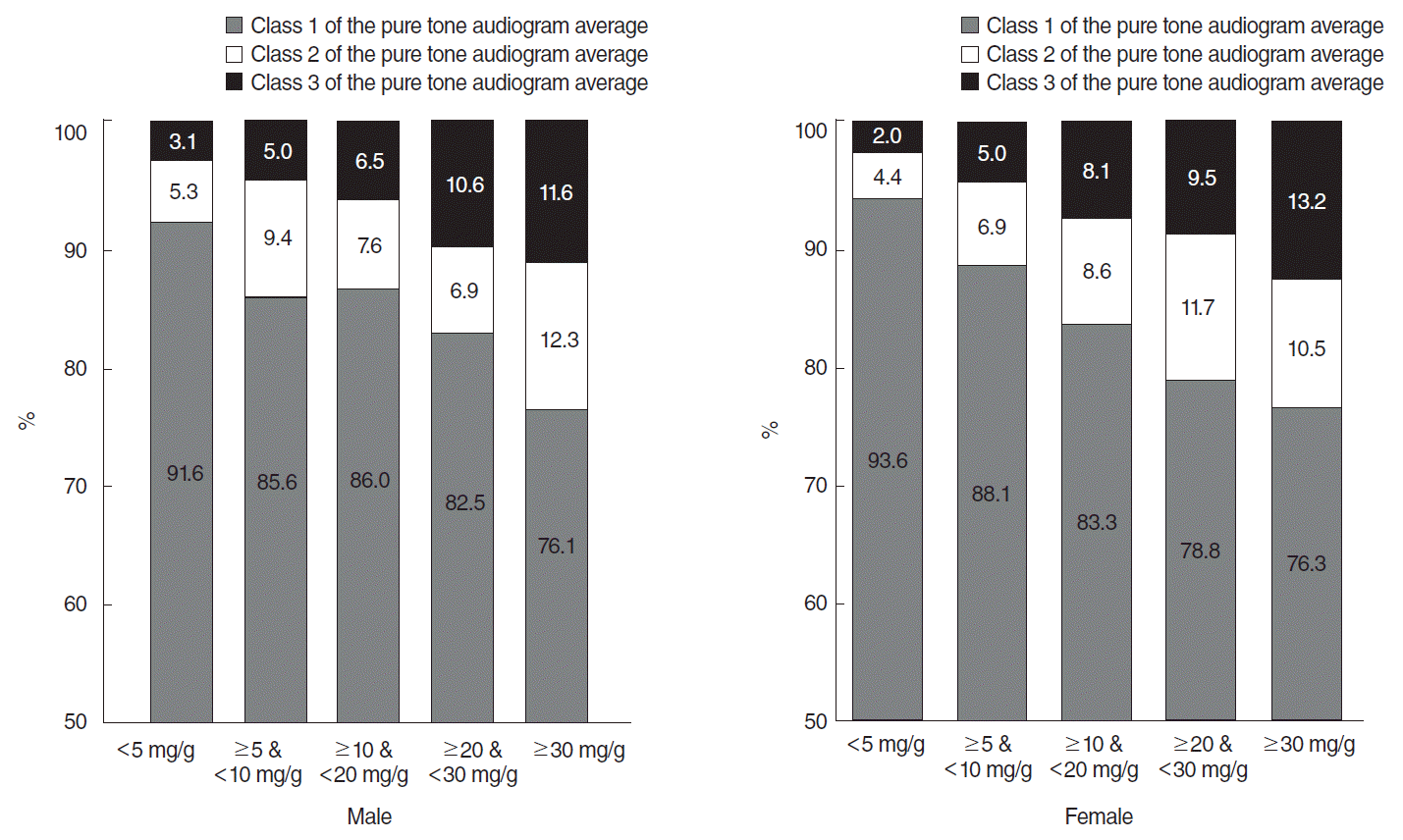1. Fetoni AR, Picciotti PM, Paludetti G, Troiani D. Pathogenesis of presbycusis in animal models: a review. Exp Gerontol. 2011; Jun. 46(6):413–25.

2. Yamasoba T, Lin FR, Someya S, Kashio A, Sakamoto T, Kondo K. Current concepts in age-related hearing loss: epidemiology and mechanistic pathways. Hear Res. 2013; Sep. 303:30–8.
3. Adler D, Fiehn W, Ritz E. Inhibition of Na+,K+-stimulated ATPase in the cochlea of the guinea pig: a potential cause of disturbed inner ear function in terminal renal failure. Acta Otolaryngol. 1980; 90(1-2):55–60.
4. Ohashi T, Kenmochi M, Kinoshita H, Ochi K, Kikuchi H. Cochlear function of guinea pigs with experimental chronic renal failure. Ann Otol Rhinol Laryngol. 1999; Oct. 108(10):955–62.

5. Kang SH, Jung DJ, Cho KH, Park JW, Yoon KW, Do JY. The association between metabolic syndrome or chronic kidney disease and hearing thresholds in Koreans: the Korean National Health and Nutrition Examination Survey 2009-2012. PLoS One. 2015; Mar. 10(3):e0120372.

6. Shen FC, Hsieh CJ. Severity of hearing impairment is positively associated with urine albumin excretion rate in patients with type 2 diabetes. J Diabetes Investig. 2014; Nov. 5(6):743–7.

7. Jacobs DR Jr, Murtaugh MA, Steffes M, Yu X, Roseman J, Goetz FC. Gender- and race-specific determination of albumin excretion rate using albumin-to-creatinine ratio in single, untimed urine specimens: the Coronary Artery Risk Development in Young Adults Study. Am J Epidemiol. 2002; Jun. 155(12):1114–9.
8. Mattix HJ, Hsu CY, Shaykevich S, Curhan G. Use of the albumin/creatinine ratio to detect microalbuminuria: implications of sex and race. J Am Soc Nephrol. 2002; Apr. 13(4):1034–9.

9. Forman JP, Fisher ND, Schopick EL, Curhan GC. Higher levels of albuminuria within the normal range predict incident hypertension. J Am Soc Nephrol. 2008; Oct. 19(10):1983–8.

10. Wachtell K, Ibsen H, Olsen MH, Borch-Johnsen K, Lindholm LH, Mogensen CE, et al. Albuminuria and cardiovascular risk in hypertensive patients with left ventricular hypertrophy: the LIFE study. Ann Intern Med. 2003; Dec. 139(11):901–6.

11. Gerstein HC, Mann JF, Yi Q, Zinman B, Dinneen SF, Hoogwerf B, et al. Albuminuria and risk of cardiovascular events, death, and heart failure in diabetic and nondiabetic individuals. JAMA. 2001; Jul. 286(4):421–6.

12. Mehta D, Pimentel DA, Nunez MZ, Abduljalil A, Novak V. Subclinical albuminuria is linked to gray matter atrophy in type 2 diabetes mellitus. Metabolism. 2014; Nov. 63(11):1390–7.

13. Kweon S, Kim Y, Jang MJ, Kim Y, Kim K, Choi S, et al. Data resource profile: the Korea National Health and Nutrition Examination Survey (KNHANES). Int J Epidemiol. 2014; Feb. 43(1):69–77.

14. Diaz de Leon-Morales LV, Jauregui-Renaud K, Garay-Sevilla ME, Hernandez-Prado J, Malacara-Hernandez JM. Auditory impairment in patients with type 2 diabetes mellitus. Arch Med Res. 2005; Sep-Oct. 36(5):507–10.
15. Bainbridge KE, Hoffman HJ, Cowie CC. Diabetes and hearing impairment in the United States: audiometric evidence from the National Health and Nutrition Examination Survey, 1999 to 2004. Ann Intern Med. 2008; Jul. 149(1):1–10.

16. Lerman-Garber I, Cuevas-Ramos D, Valdes S, Enriquez L, Lobato M, Osornio M, et al. Sensorineural hearing loss: a common finding in early-onset type 2 diabetes mellitus. Endocr Pract. 2012; Jul-Aug. 18(4):549–57.
17. Abd El Dayem SM, Abd El Ghany SM, Beshr AE, Hassan AG, Attaya MS. Assessment of hearing in children with type 1 diabetes mellitus. J Pediatr Endocrinol Metab. 2014; May. 27(5-6):393–402.

18. Konrad-Martin D, Reavis KM, Austin D, Reed N, Gordon J, McDermott D, et al. Hearing impairment in relation to severity of diabetes in a veteran cohort. Ear Hear. 2015; Jul-Aug. 36(4):381–94.

19. Kang JW, Choi HS, Kim K, Choi JY. Dietary vitamin intake correlates with hearing thresholds in the older population: the Korean National Health and Nutrition Examination Survey. Am J Clin Nutr. 2014; Jun. 99(6):1407–13.

20. Hong JW, Jeon JH, Ku CR, Noh JH, Yoo HJ, Kim DJ. The prevalence and factors associated with hearing impairment in the Korean adults: the 2010-2012 Korea National Health and Nutrition Examination Survey (observational study). Medicine (Baltimore). 2015; Mar. 94(10):e611.
21. Lee JS, Kim DH, Lee HJ, Kim HJ, Koo JW, Choi HG, et al. Lipid profiles and obesity as potential risk factors of sudden sensorineural hearing loss. PLoS One. 2015; Apr. 10(4):e0122496.

22. Ra H, Yoo JH, Ban WH, Song HC, Lee SS, Kim SR, et al. Predictors for diabetic retinopathy in normoalbuminuric people with type 2 diabetes mellitus. Diabetol Metab Syndr. 2012; Jul. 4(1):29.

23. Yoon HE, Kim ES, Mo EY, Shin SJ, Moon SD, Han JH. High normal albuminuria is associated with arterial stiffness and carotid atherosclerosis in Korean patients with type 2 diabetes. Nutr Metab Cardiovasc Dis. 2015; Aug. 25(8):787–94.

24. Liu JJ, Tavintharan S, Yeoh LY, Sum CF, Ng XW, Pek SL, et al. High normal albuminuria is independently associated with aortic stiffness in patients with Type 2 diabetes. Diabet Med. 2014; Oct. 31(10):1199–204.

25. Leoncini G, Sacchi G, Ravera M, Viazzi F, Ratto E, Vettoretti S, et al. Microalbuminuria is an integrated marker of subclinical organ damage in primary hypertension. J Hum Hypertens. 2002; Jun. 16(6):399–404.

26. Leoncini G, Viazzi F, Parodi D, Ratto E, Vettoretti S, Vaccaro V, et al. Mild renal dysfunction and cardiovascular risk in hypertensive patients. J Am Soc Nephrol. 2004; Jan. 15 Suppl 1:S88–90.
27. Whitmer WM, Howell P, Akeroyd MA. Proposed norms for the Glasgow hearing-aid benefit profile (Ghabp) questionnaire. Int J Audiol. 2014; May. 53(5):345–51.





 PDF
PDF Citation
Citation Print
Print



 XML Download
XML Download